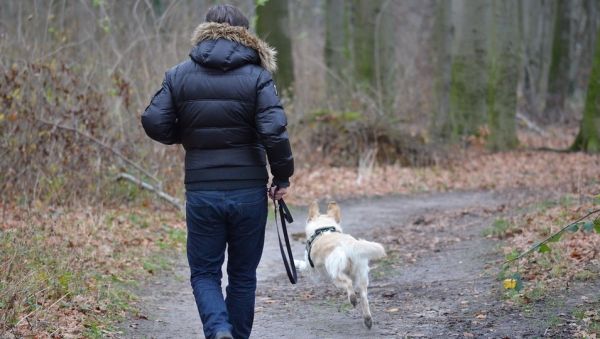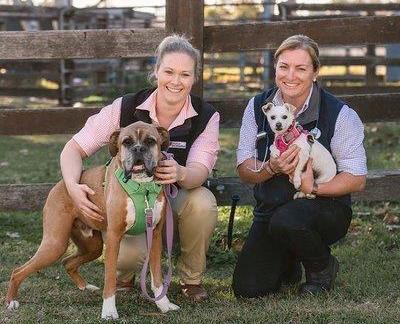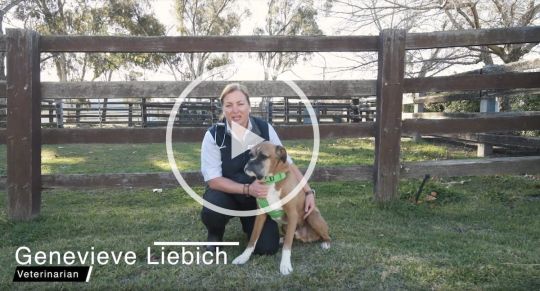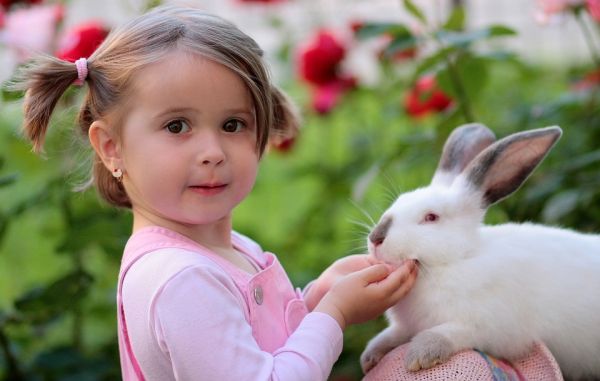 |
|

|
 |
 |
July Small Animal Newsletter |
July 2018 |
 |
|
 |
Mid winter in Orange and it's great to pull on the boots, grab the leads and enjoy a walk with your dogs in the crisp outdoors on a sunny day.
If you live in the city, a town or village you will need to have either a collar or harness on your dogs when walking to keep them safe and under control. We see quite a few different styles of restraint when our patients visit us and we think it's time for some more information about the best type of harness to look for when buying one for your dog.
Genevieve and Rosie explain the important things to consider - read on!
|
 |
 |
|
|
|
 |
 |
01 Why we recommend the use of harnesses |
 |
 |

Which harness to choose?
With so many devices on the market to assist dog owners in walking and training their dogs, we would like to discuss why we recommend the use of a front attaching harness.
There are so many different styles of harnesses on the market, many of which are aimed at reducing pulling during walking. Unfortunately the most common and popular designs where the lead attaches only at the back encourages the dog’s reflex (called the opposition reflex) to pull harder against the pressure. The Ruffwear front attaching harnesses do not encourage this opposition reflex in the same way.
The design of some of these harnesses also end up causing major damage to the soft tissue structures in the shoulder (e.g. biceps tendon, shoulder blade and shoulder joint) and result in forelimb lameness. Attaching a leash to a collar, choke chain or head halter also puts unnecessary tension on the neck, which in a dog that pulls a lot could result in damage to the wind pipe or trachea and aggravate or cause neck pain.
Things to consider when purchasing a harness
- Proper and personalised fit – the harness should not be tight in order to stay in place. You should be able to slip your hands easily into any area of the harness and there should be no pinching or discomfort when pulling on the harness.
- Full free limb movement – the animal should be able to move their limbs through their normal full range of motion and not have any resistance blocking normal functional movement.
- Avoid harnesses that have straps across the front of the dog’s chest or shoulder as this puts unnecessary tension on important structures needed for normal gait.
- Equal weight distribution throughout the harness - padded harnesses assist with even weight distribution and add comfort.
At Orange Vet Hospital we stock a range of Ruffwear Front Range Harnesses.
The Ruffwear Front Range Harness is a padded everyday harness that is quick and easy to use for any sized dog. It has two points of attachment – an aluminium D-ring centred on the dog's back for everyday walks, and a reinforced webbing loop at the dog's chest for training or additional control. It has four points of adjustment to ensure correct and personalised fit and comes in a range of fun colours. These harnesses are recommended for any dog, especially those that are undergoing post-operative rehabilitation, brachycephalic breeds (short nosed breeds e.g. Pugs) and for those dogs that pull excessively.
For a personalised fit please see one of our staff members who would be more than happy to assist with fitting a harness to your dog.
Check out our video to hear Genevieve and Rosies' advice.

|
 |
 |
|
 |
 |
02 Rabbit feeding |
 |
 |
 photo credit pixabay
|
|
 |
A rabbit in the house?
Rabbits make great (& very cute) pets, particularly for kids, however it is important to know how to provide them with the balanced diet they require for good health. Vet Nikki explains the whats and whys of their dietary needs.
"Rabbits require a continuous source of a high fibre diet. This assists with wearing of the teeth, gut motility and preventing boredom. Commercial pelleted or mixes alone do not provide the volume of feed needed.
What to feed
Mostly (70-80%) grass hay such as Timothy, oaten or pasture hay. Lucerne and clover hays are not suitable as they contain high levels of calcium and protein. This can cause long term health problems such as bone disease and urinary tract disorders.
Diet should be supplemented with two packed cups of fresh greens per kilogram of bodyweight and a small amount of pellets (Vetafarm). Greens include broccoli, cabbages, celery, beet/carrot tops, brussel sprouts, spinach leaves, Asian greens, chicory, kale and dark leaf lettuce. Suitable herbs include parsley, dandelion, coriander, basil, dill and mint.
Treats
Treats should be limited to 1-2 tablespoons per rabbit/day. Suitable treats include; most fruits, root vegetables such as carrot & sweet potato and capsicum.
What NOT to feed
Cereals, grains, nuts, seeds, corn, beans, peas, biscuits, sugar, iceburg lettuce, breakfast cereal and chocolate."
Thanks Nikki for these feeding tips for keeping our rabbit pets healthy and happy.
|
 |
 |
|
 |
 |
03 Top tips for nail trimming at home |
 |
 |
|
 |
Six steps for nail trimming at home:
1. Be prepared - get all of your equipment ready first, including some of your pet's favourite treats!
2. It is easier to have your pet in a sitting or lying down position. Cat's might feel safer wrapped in a towel.
3. Hold your pet's paw and apply gentle pressure to the base of the nail to help move the nail away from the pad (this is particularly helpful in cats.)
4. Trim the tip of the nail at the point where it curves around. It's always best to take less rather than too much. Avoid trimming the quick (nail bed) - this can be seen in a white nail (pink tissue) but not so easily in a black nail. Ask us to demonstrate where to trim your pet's nail's. If you do happen to cut too far and there is a bit of blood, don't worry, just use a cake of soap to 'plug' the nail and stop the bleeding!
5. Reward your pet after each nail is trimmed - food treats are great and create a positive experience for your pet.
6. Don't forget to trim the dew claws on the inside of each fore-leg (and in some pets, the hind-leg). These nails are easy to miss but are often the longest nails as they are not worn down as your pet walks.
Ask us for more information or for a demonstration. And never feel bad asking us to trim your pet's nails - we are always here to help!
|
 |
 |
|
|
|
|
|
 |
 |
06 Grain-free diets - are they better? |
 |
 |
|
 |
Many people assume that grain-free diets are 'more natural' and carbohydrate-free. They also have the conception that grain-free diets are less likely to cause allergies. But none of this is true!
There has been no scientific evidence to prove that grain-free diets are better for our pets, but the growing number of these products on the market is giving the misperception that grain is bad for pets.
Some of the misconceptions about grain-free diets include:
1. Grains may be used as fillers in pet foods: The term 'filler' indicates there is no nutritional value. Various grain products provide protein, which may be easier for the pet to digest than some proteins from meat. Most dogs and cats (greater than 90%) can easily utilise and digest nutrients from grains normally found in pet foods.
2. Grains cause food allergies: Food allergies in pets are uncommon and grain allergies are even more uncommon. They are more likely to be caused by an animal protein (eg, chicken, beef, or dairy.)
3. Grains cause gluten intolerance: Coeliac disease is an inherited autoimmune disease seen in humans that has been associated with sensitivity to gluten proteins in wheat and grains, such as barley and rye. Gluten intolerance is extremely rare in dogs and nonexistent in cats.
4. Grain-free pet foods are carbohydrate free: Grain-free pet foods often contain carbohydrates from other sources such as sweet potatoes, which have a higher carbohydrate level than corn. Grains are carbohydrates, which are an important energy source, and one of the six basic nutrients required for a healthy life (i.e. water, protein, fat, carbohydrates, vitamins, minerals.)
Remember, there is no scientific evidence to suggest that grain-free diets offer more health benefits than a diet with grains, but if you need more information or want to discuss which diet is most suitable for your pet, you should ask us today.
|
 |
 |
|
 |
 |
07 Is your pet is overweight? |
 |
 |
|
 |
The best way to tell if you pet is overweight is to take a good look at them!
Here's how ...
+ Peer down on your pet from above.
+ An overweight pet will have lost definition of their waist
+ Instead of an hourglass figure they might look a bit rotund and may even resemble a coffee table!
+ You will also have a bit of trouble feeling their ribs when you run your hands over their sides
+ A very obese pet will have neck fat, a round tummy as well as fat deposits over the hips
You might think carrying a few extra kilos isn't a big deal, but unfortunately overweight pets are at an increased risk of arthritis, heart disease, respiratory disorders and diabetes. What is alarming is that most people aren’t even aware that their pet is a bit portly.
If you are worried about your pet's weight, we recommend that you drop-in for a weight check with us. We will assess and discuss with you your pet’s body condition and, if necessary, start a weight loss plan.
What to do if your pet is a bit portly ...
Getting your pet to lose weight is easier than you think! Exercise will help but it is absolutely crucial to feed your pet the correct diet and the right amount. Did you know that we have diets available that will actually increase your pet’s metabolic rate to help your pet lose weight? Just ask Lenno! He is able to maintain his svelte like figure on this diet and keeping him this way has never been easier.
OVH's 4 Paws Kilo Club is a great place for portly pets to start - we support your pet with an initial evaluation, diet and exercise recommendations and weekly weigh ins to track their progress. We are always happy to help you out in this department and are the best people to ask for more information.
And finally, check out this dog's attempt at exercise on YouTube. Did you know that his yawn is actually a sign of anxiety (and he's not tired)? Maybe he's anxious about the thought of exercise?!
|
 |
 |
|
|